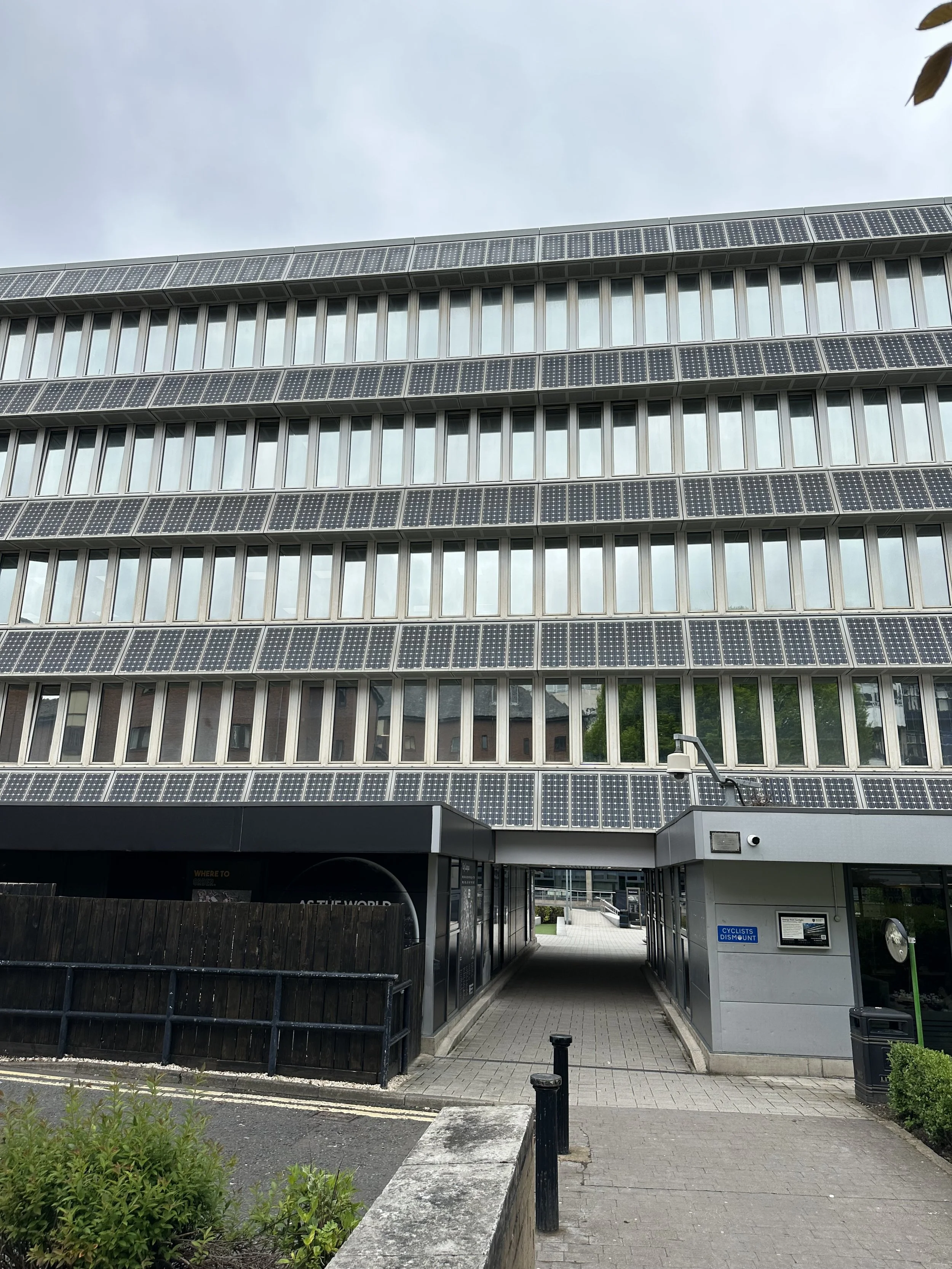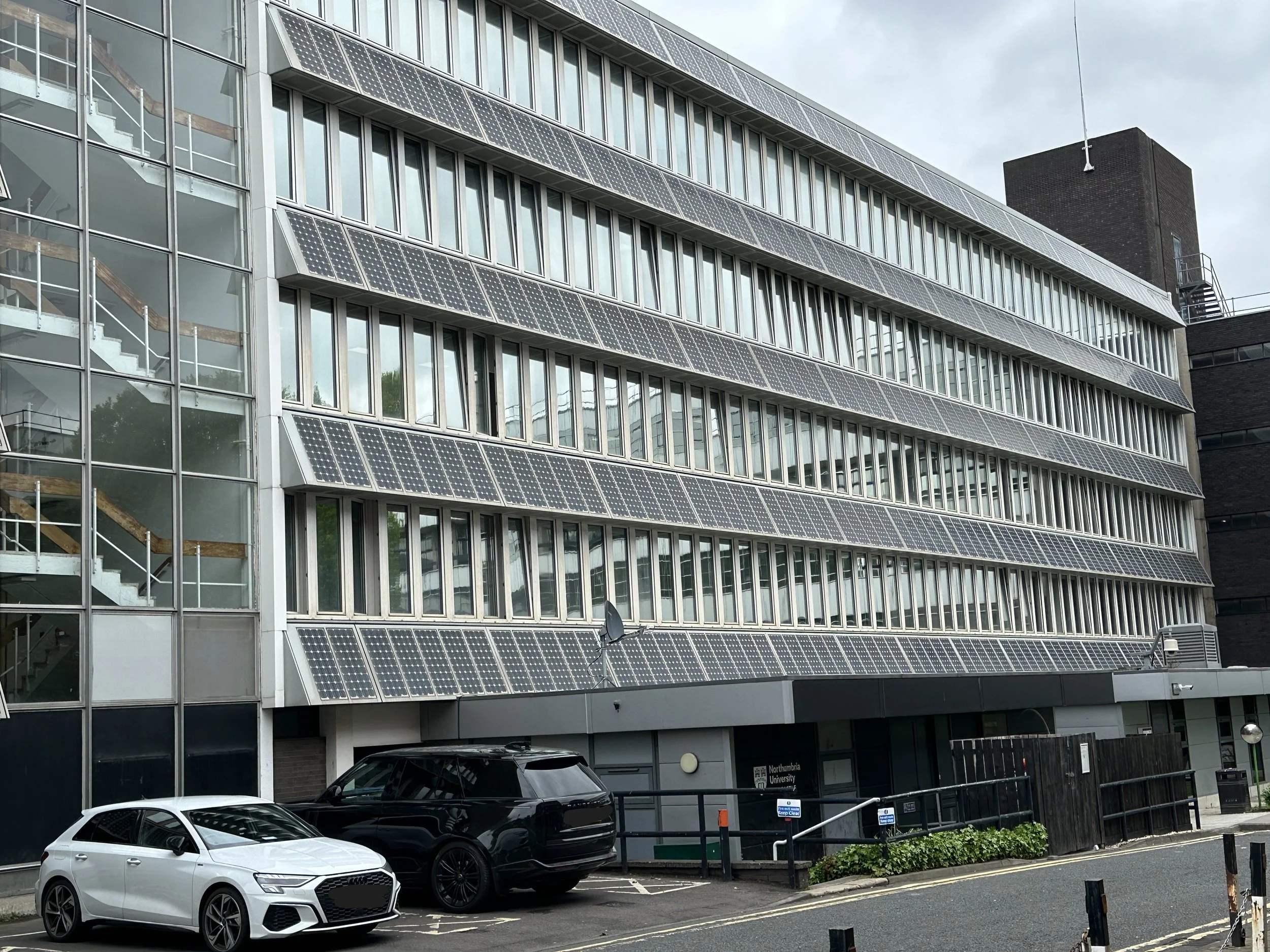Northumberland Building Façade
Not only was the array the country’s first building integrated PV installation, but at 39.5 kWp it was also as one of the largest building integrated photovoltaic systems in Europe at that time.
It is nearly 30 years since the solar PV façade at the University of Northumbria (formerly Newcastle Polytechnic) was commissioned. At the time, the 39.5 kWp system was the first building-integrated PV (BIPV) project in the UK and the largest such installation in Europe.
Back in the 1980s and early 1990s, the Newcastle Photovoltaic Applications Centre (NPAC) was one of the few PV research groups in the UK. Established by the late Professor Robert (Bob) Hill, NPAC was based in the Department of Electronic, Electrical Engineering and Physics at the Polytechnic. Although the Centre no longer exists in its own right, its legacy lives on. One of Bob’s many achievements was to secure funding from the European Commission’s THERMIE Programme, together with UK Government support as well as private sponsorship for the installation of the PV façade on the Northumberland Building (the façade is now known as the Robert Hill Façade in memory of Bob).
The THERMIE programme aimed to encourage the development of new and innovative energy technologies. Financial support was provided for projects aimed to promote and disseminate advanced and innovative technologies which might not easily be put into effect otherwise, owing to financial (rather than technological) risks.
Installed in 1994 on the southerly elevation of the building as part of a wider renovation and refurbishment, the system was designed and installed by a partnership which included NPAC, IT Power, Ove Arup & Partners, BP Solar and Façade Technologies. Subsequent monitoring and analysis of the system’s performance provided invaluable data on how solar PV performed in buildings in urban environments.
The PV system used a total of 465, high-efficiency mono-crystalline silicon photovoltaic modules manufactured by BP Solar, which were incorporated into the façade cladding. The PV modules were installed at an angle on the façade which helped to capture more sunlight as well as to provide shade to the windows below during the summer months. The angled installation also helped the natural ventilation between the modules and the wall, thereby enhancing their efficiency: this also helped prevent the building from overheating during the summer months. The PV modules were hard-wired back to a single 40 kW inverter made by Siemens: this was in the days before MC4 connectors had been invented. When the panels were installed, they were covered in a black plastic sheeting so that they were not live during the installation process. The black plastic covering was then removed from a cherry-picker once the system had been fully connected.
Each PV module had a rated power of 85Wp – at 13.5% efficiency, these were the highest efficiency panels available anywhere in the world at the time: compare this to the typical modules today which have power ratings of 450Wp and an efficiency of 22.5%. Five of the PV modules were series-connected together in a single architectural cladding unit. The electrical connections from each cladding unit were further connected in series with two other units resulting in 15 modules per string: a total of 31 strings were then connected in parallel through a DC switch box before connecting to a central inverter (which used thyristors rather than IGBTs) – this was also in the days before string inverters which would have resulted in a very different design had the system been installed today.
The PV modules utilised a ground-breaking technology developed and patented by the University of New South Wales (UNSW) back in 1984. Researchers at UNSW, led by Professor Martin Green, developed the “laser-grooved, buried grid” technology which was then licenced by BP Solar. This technology was an innovative design which significantly improved the efficiency of silicon solar cells. The key innovation was the front contacts on the solar cells were buried in a lasered groove cut into the substrate of the cell which meant that less of the active cell area was obstructed (shaded) by the front contacts resulting in significantly reduced front shading losses when compared to the traditional screen-printing.
In 2015, the old Siemens inverter finally gave up the ghost after 20 years of operation and was replaced with modern string inverters. To this date, the PV array is still fully operational and generates around 25,000 kWh each year, saving 11 tonnes of CO2 annually.
Photon’s Managing Director, Jonathan Bates, did his PhD at NPAC at the time the Robert Hill Façade was installed and subsequently worked as a Post-Doctoral Research Associate at NPAC for 2 years working on different options for integrating solar PV in to building façade elements.
Alison Wilshaw, Head of Renewables for Northern Europe at Rina Tech UK completed her PhD on the performance of the façade in a study which also considered the performance of various different PV technologies available at the time including amorphous silicon and cadmium telluride modules. Her doctoral thesis contributed significantly to the understanding of PV in the built environment.
Attached pictures:
1) Picture was taken after the installation was completed in 1995.
2) Covered live panels with black plastic sheet that was removed after the installation was completed.
3) and 4) The installation in 2024.




